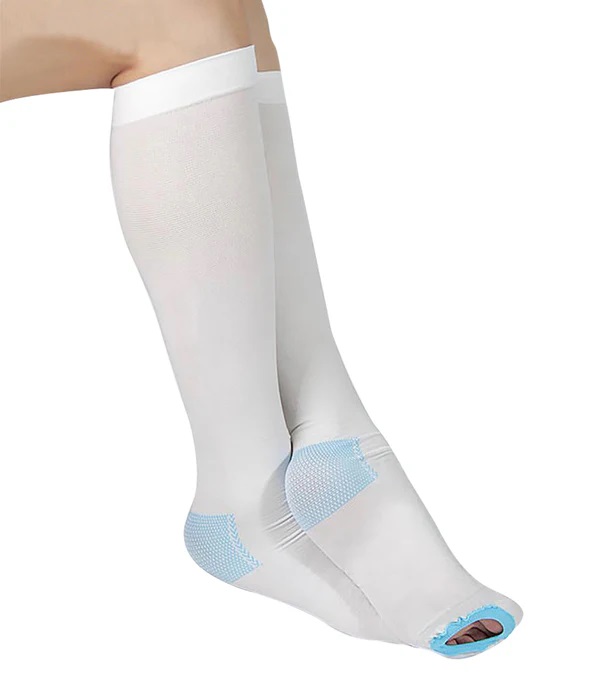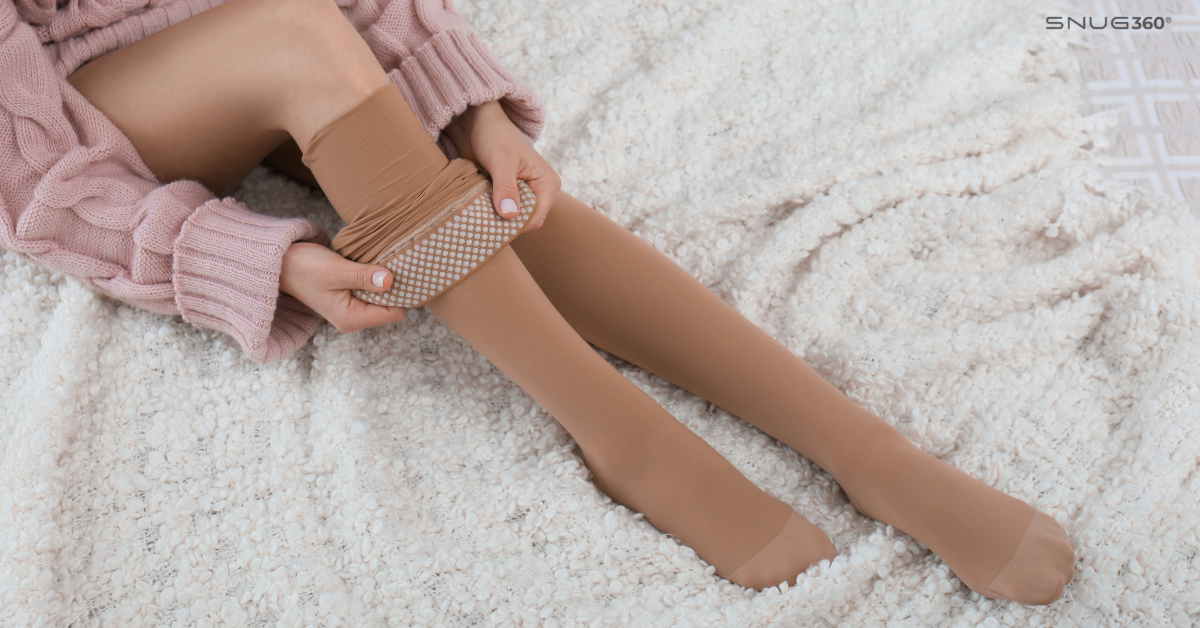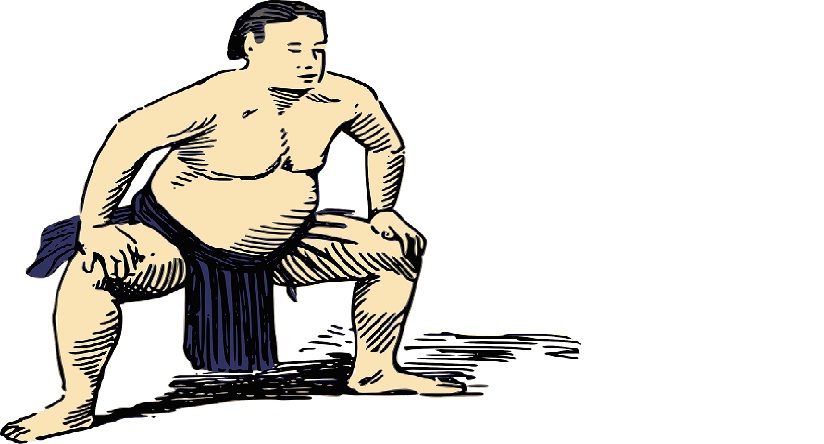Maintaining healthy legs and proper circulation is integral to overall well-being, but some individuals' risk of Deep Vein Thrombosis (DVT) necessitates additional protection, such as anti-embolism compression socks.
This comprehensive guide offers extensive insights into anti-embolism compression socks, providing essential knowledge to make informed decisions about leg health.
What are Anti-Embolism Compression Socks?
Anti-embolism compression socks are medical-grade garments designed to provide graduated compression to the legs. Constructed of durable elastic materials that comfortably conform around legs while exerting pressure to promote blood circulation, they may be prescribed for post-surgery recovery, immobility due to illness or injury, and long periods spent sitting or standing.
Types of Anti-Embolism Compression Socks
Anti-embolism compression socks come in several varieties based on length and design. Common examples are knee-high and anti-embolism stockings thigh-high, the former providing compression from just below the foot to just above the knee. At the same time, thigh-high designs extend up the leg towards the upper thigh region. Open and closed-toe designs also exist to meet personal preferences or address medical conditions like accommodating bandages or foot conditions.
Materials used to manufacture these socks vary, with latex-free options usually being made available for those with latex allergies or sensitive skin. Length and material selection depend upon each patient's unique medical condition and comfort preferences.
Benefits of Anti-Embolism Compression Socks
Anti-embolism compression socks' primary benefit lies in their ability to help prevent Deep Vein Thrombosis (DVT) and its potentially lethal complication, pulmonary embolism (PE). Anti-embolism compression socks work by applying graduated pressure along each leg - starting at the ankle and gradually decreasing upwards towards the calf area - in a squeezing action which helps:
Help Improve Blood Flow: By exerting some pressure on veins, compression socks help push blood upward toward the heart, preventing pooled and pooling blood from pooling and potentially clotting. This increased circulation can reduce leg swelling, aches, and feelings of heaviness in the legs.
Reduce Pain & Discomfort: Compression socks can provide significant relief to individuals suffering from varicose veins or chronic venous insufficiency, where valves in their veins malfunction and allow blood to backflow backward by keeping it flowing in its intended direction, helping reduce swelling, pain, throbbing sensations and other symptoms associated with blood flow issues. The pressure helps ensure proper blood flow to reduce symptoms such as swelling, pain, and throbbing sensations in this way.
Enhance Recovery: After surgery, especially leg surgery, swelling and discomfort are commonplace. Anti-embolism compression socks can significantly speed up healing while decreasing swelling by improving blood flow and decreasing fluid accumulation.
Athletic Performance Improvement: Although research remains incomplete, some athletes use compression socks for perceived advantages in athletic performance and recovery. According to theory, compression helps reduce muscle fatigue while increasing proprioception (body awareness) and decreasing post-exercise muscle soreness.
Choosing the Best Anti-Embolism Compression Socks
Selecting the best anti-embolism socks requires taking into account several key criteria to ensure they meet both your medical needs and comfort preferences. Here are a few things to keep in mind when making your selection:
Compression Levels: Compression socks come in various compression levels, ranging from mild (8-15 mmHg) to moderate (15-20 mmHg) and high (20-30 mmHg or higher), depending on your medical condition, mobility level, and healthcare provider's advice. Higher compression levels may be appropriate post-surgery for managing severe swelling.
Sizing and Fit: Appropriate sizing is crucial for therapeutic socks to provide their intended benefits. Most manufacturers provide size charts based on calf circumference and ankle size to help you find a good match. When measuring legs accurately in the morning when swelling levels are at their lowest, taking an accurate reading is critical to achieving a snug yet comfortable fit without restricting circulation.
Material and Design: Consider what material composition and features align with your preferences and any skin sensitivities you may have. Look for socks made of breathable, moisture-wicking materials that improve comfort and durability. Seamless construction with reinforced stitching at stress points can prevent irritation for extended wearability.
Brand and User Reviews: Investigating well-recognized brands known for quality compression garments can give insight into product reliability, customer satisfaction, and durability. User reviews provide valuable feedback regarding comfort levels when wearing compression apparel to reduce swelling or improve circulation, as well as overall satisfaction with the product.
How to Wear Anti-Embolism Compression Socks?
Wearing anti-embolism compression socks may initially seem challenging, but with practice, it becomes simpler. Here is a step-by-step guide on how to put them on:
Prep Time: Before beginning this task, make sure your legs are clean and dry. Apply lotion as necessary, but avoid oil-rich products as these could compromise grip. Attempt this task early in the morning when your legs will likely be less swollen.
Sock Inversion: Grab the sock by its heel and pinch above it; invert and flip inside out up to its heel section in order to create an easier surface for donning. This process creates a more seamless and comfortable wearing experience.
Foot First: Gently slip your foot into the sock, making sure the heel cup is properly aligned. Think of this step as donning a glove specifically tailored for your foot!
Gradual Ascent: Use a smooth upward motion to gradually pull up your sock over your leg. Be patient, as sudden movements could damage the material of the sock; instead, think of this process as a slow and steady climb.
Wrinkle Patrol: When pulling up your sock, ensure there are no wrinkles or bunching. Smooth out any creases with firm but gentle pressure for optimal comfort and compression.
Double Duty: After fitting one sock on one leg, try the same steps on the other leg to perfect this step. Practice makes perfect!
Caring for Your Compression Companions
Just like any trusty companion, anti-embolism compression socks require some TLC in order to perform at their peak and remain by your side for as long as possible. Here's how you can show yours some love:
Gentle Wash, Big Impact: Switch out harsh chemicals for gentle handwashing in lukewarm water using mild detergent, and avoid bleach and fabric softeners that could potentially harm delicate fibers.
Air It Out: Socks need time to dry without direct sunlight in order to retain their elasticity, helping your circulation stay on track. Allow them to air dry naturally until dry. This preserves their shape while keeping circulation flowing smoothly.
Storage Matters: For optimal sock storage, store socks in a cool and dry place when not being worn or used. Avoid stuffing them into drawers too tightly, as this might cause them to lose their shape over time.
Listen to the Label: Every brand varies, so pay close attention to any washing instructions provided by its manufacturer. While machine-washable socks may exist, following specific recommendations ensures optimal lifespan and lifespan.
By adopting these basic practices into your routine, you will extend the lifespan of your compression socks and ensure they continue to provide reliable assistance for healthy circulation and DVT prevention.
Conclusion
Anti-embolism compression socks can be an invaluable asset in maintaining good circulation and warding off DVT, so SNUG360 offers high-quality anti-embolism compression socks recommended by doctors. With anti-embolism knee-high socks option for your convenience - to promote overall leg health. Their selection provides the ideal match to meet individual requirements; explore now to discover which size and compression level best suit you!









